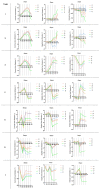Effect of Different Anchorage Reinforcement Methods on Long-Term Maxillary Whole Arch Distalization with Clear Aligner: A 4D Finite Element Study with Staging Simulation
- PMID: 38275571
- PMCID: PMC10813679
- DOI: 10.3390/bioengineering11010003
Effect of Different Anchorage Reinforcement Methods on Long-Term Maxillary Whole Arch Distalization with Clear Aligner: A 4D Finite Element Study with Staging Simulation
Abstract
The objective of this study was to examine how various anchorage methods impact long-term maxillary whole arch distalization using clear aligners (CAs) through an automated staging simulation. Three different anchorage reinforcement methods, namely, Class II elastics, buccal temporary anchorage device (TAD), and palatal TAD, were designed. Orthodontic tooth movement induced by orthodontic forces was simulated using an iterative computation method. Additionally, the automatic adjustment of the CA was simulated through the application of the thermal expansion method. The results indicated that the palatal TAD group had the largest retraction of incisors, followed by the buccal TAD group and the Class II elastic group, while the least was in the control group. The largest distal displacements and efficiency of molar distalization for the first and the second molars were noticed in the palatal TAD group. Arch width increased at the molar and premolar levels in all groups. The FEM results suggested palatal TAD had the best performance considering anterior teeth anchorage maintenance, both sagittally and vertically. However, attention should be paid to the possible increasement of arch width.
Keywords: clear aligner; finite element method; long-term simulation; molar distalization; orthodontics; tooth movement.
Conflict of interest statement
The authors declare no conflicts of interest, either directly or indirectly, in the information or products listed in this paper.
Figures










References
Grants and funding
- PKUSSNCT-23A11/New Clinical Techniques and Therapies of Peking University School and Hospital of Stomatology
- PKUSS20200114/Peking University School and Hospital of Stomatology
- B4-WXEA2012359/Scientific Research Project of Clear Aligner of Peking University School and Hospital of Stomatology
- 62076011/National Natural Science Foundation of China
- 62306017/National Natural Science Foundation of China
LinkOut - more resources
Full Text Sources

